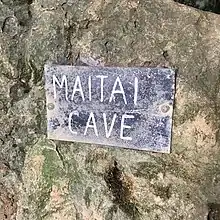Hadopyrgus ngataana
Hadopyrgus ngataana is a tiny, transparent, and critically endangered freshwater snail, found only in a single stream in a cave in New Zealand.
| Hadopyrgus ngataana | |
|---|---|
| Scientific classification | |
| Kingdom: | Animalia |
| Phylum: | Mollusca |
| Class: | Gastropoda |
| Subclass: | Caenogastropoda |
| Order: | Littorinimorpha |
| Family: | Tateidae |
| Genus: | Hadopyrgus |
| Species: | H. ngataana |
| Binomial name | |
| Hadopyrgus ngataana Haase, 2008[2] | |
| Synonyms | |
| |
Habitat

This snail has only been found in one spot: in one pool, in a stream at the entrance of Maitai Cave, in the Maitai River Valley southeast of Nelson. It is one of a group of very small, blind, transparent freshwater snails found in caves or underground streams,[3] especially in Northwest Nelson, and like many of these species has evolved in just one small area.[4]
Taxonomy
The tiny (1.7 x 1.2 mm)[5] snail was discovered by Frank Climo in the 1970s, but was considered to be just one form of another subterranean Hadopyrgus snail found in the Nelson area.[3][6] In 2001 Martin Haase and Christina Mosimann collected more specimens from Maitai Cave by washing and sieving gravel, and using both morphological and genetic evidence realised these belonged to a distinct species.[7] They scientifically described and named it Hadopyrgus ngataana in 2008;[2] the name they chose, ngataana, comes from the Māori words ngata (snail or slug) and ana (cave).[6]
Conservation status
In November 2018 the Department of Conservation classified H. ngataana as Nationally Critical, using the New Zealand Threat Classification System.[1] The species meets the Nationally Critical criteria because it is found in just one location, and occupies a total area of less than 1 hectare.[1] Because Maitai Cave is a popular recreational area, and the stream the species has evolved in is so small, the population of this critically endangered snail is expected to decline.[1]
While it is possible for freshwater invertebrates to be legally protected under the Wildlife Amendment Act 1980, neither H. ngataana nor any other New Zealand freshwater invertebrate has been protected.[8]
References
- Grainger, N.; Harding, J.; Drinan, T.; Collier, K.; Smith, B.; Death, R.; Makan, T.; Rolfe, J. (November 2018). "Conservation status of New Zealand freshwater invertebrates, 2018" (PDF). New Zealand Threat Classification Series. 28: 1–29 – via Department of Conservation.
- Haase, Martin (2008). "The radiation of hydrobiid gastropods in New Zealand: A revision including the description of new species based on morphology and mtDNA sequence information". Systematics and Biodiversity. 6 (1): 99–159. doi:10.1017/S1477200007002630.
- Climo, F. M. (1974). "Description and affinities of the subterranean molluscan fauna of New Zealand". New Zealand Journal of Zoology. 1 (3): 247–284. doi:10.1080/03014223.1974.9517834. ISSN 0301-4223.
- Collier, Kevin (28 February 2007). "Revealing the diversity of New Zealand hydrobiid snails". NIWA. Retrieved 21 October 2015.
- "Hadopyrgus ngataana Haase, 2008". New Zealand Mollusca. Retrieved 21 October 2015.
- Arnold, Naomi (11 December 2015). "New Zealand's loneliest snail that calls Nelson's Maitai Caves home". Nelson Mail. Fairfax Media. Retrieved 11 December 2015.
- "Object: Freshwater snail, Hadopyrgus ngataana Haase, 2008; holotype | Collections Online - Museum of New Zealand Te Papa Tongarewa". collections.tepapa.govt.nz. Retrieved 2015-10-21.
- Miskelly, Colin (2016), "Legal protection of New Zealand's indigenous aquatic fauna–an historical review" (PDF), Tuhinga, 27: 84
External links
| Wikispecies has information related to Hadopyrgus ngataana. |
- Image of the holotype specimen held at Museum of New Zealand Te Papa Tongarewa
- Hadopyrgus ngataana discussed on RNZ Critter of the Week, 23 November 2018
